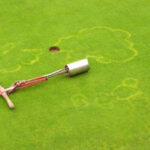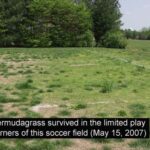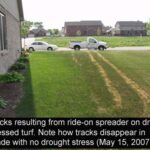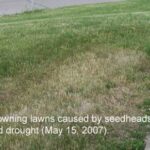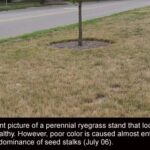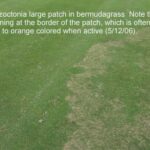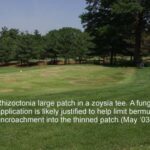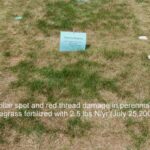Category: Disease Control
Brown Ring Patch / Waitea Patch
There are sporadic reports of brown ring patch (formerly called Waitea patch) from across the Midwest . Interestingly, the disease currently is causing concern in southern California as well. The risk of structural damage (a.k.a. dying turf) is greater on putting greens than on turf mowed at a half inch or higher. Otherwise, effects are […]
Bermudagrass Winter Survival and Cultivar Selection
With the bermudagrass damage in southern IN and Kentucky , we are fielding many questions on cultivar survival. Following is our winterkill data from 2003 of bermudagrass grown in West Lafayette under fairway conditions. Combining this data and other data from across the country, I would recommend in order the following cultivars of bermudagrass for […]
Winter damage on bermudagrass
As bermudagrass begins to green up in southern IN and Kentucky , it is apparent that moderate to severe winter damage has occurred. Though we may be a little premature because full green-up and growth is still a week or two away depending on temperatures, it’s important to start formulating a strategy to repair the […]
Brown Tracks in Lawn
With the mild drought stress over the last week, lawns are extremely susceptible to cosmetic damage from mowers, spreaders, and human traffic (photos). Drought stress may not have been easily visible before mowing. Turf likely was at the drought stressed stage where footprints (or mower tracks) remain in the turf and don’t snap back like […]
Lawns turning brown overnight?
We have received a number of calls, email, and electronic photos inquiring about brown patches to entire lawns turning brown apparently overnight (see photos). Following are the three most likely culprits: • Seedheads – Especially on perennial ryegrass lawns, seed heads mowed by an even a marginally sharp blade will fray and turn brown as […]
Gray Leaf Spot Update
There have been several reports of gray leaf spot outbreaks throughout Indiana and the lower Midwest during the past two weeks. The disease will develop over a broad range of environmental conditions (not just hot and wet). Our research results showed that the presence of inoculum is the disease-limiting factor north of the Ohio River. […]
Brown Patches in Lawns Could be Old Seedstalks
We have received a number of calls, email, and electronic photos inquiring about current brown patches in the lawn. Dollar spot is active throughout the state and could be causing problems in lawns. Dollar spot causes very noticeable lesions and cotton candy mycelium in the early morning. However, many of the patches that I have […]
Red thread, pink patch, and dollar spot in lawns and roughs
Red thread and its close relative pink patch, are now appearing on home lawns (and golf course roughs) in the central and southern parts of Indiana. Red thread first appears as small (quarter to golf ball size) gray – tan colored patches in the turf. After extended dew periods, white – pink mold may be […]
Pink Snow Mold Active
The cool wet weather the last two weeks is favoring Microdochium nivale, the pathogen that causes pink snow mold (sometimes referred to as Microdochium patch). The color of pink snow mold scars indicates the activity of the patch. Straw colored patches are usually inactive. However, a rust to orange colored band or ring indicates an active […]
Rhizoctonia Large Patch in Bermudagrass
With the continued cool wet weather, Rhizoctonia Large Patch (RLP) is affecting bermudagrass fairways. Prior to widespread use of bermudagrass in southern Indiana and northern Kentucky, we thought RLP affected only zoysia and was thus known as zoysia patch. However, RLP caused serious thinning in bermudagrass in an occasional spring the last few years. This […]
Rhizoctonia Large Patch (Zoysia Patch) in Zoysia
With the continued cool wet weather, Rhizoctonia Large Patch (RLP or zoysia patch) is in high gear. This follows a warm winter that also encouraged RLP, which is the only major disease of zoysiagrass in Indiana. Like snow mold, a rust to orange colored band on the outside of the patch indicates activity. Though best […]
Tough Year for Turf in Indiana
The summer’s heat and humidity have taken an unusually high toll on turf in lawns, athletic fields, and golf courses. Most of the decline can be attributed to poor root growth weakening cool-season grasses and starting an avalanche of secondary factors leading to further decline. Root growth of cool-season grasses reaches a peak in mid-spring […]
Rust in Turf
A few rust calls are starting to trickle in, which is typical at this time of the year. Rust symptoms are reddish-orange lesions or spots on the leaf blades and a rust-colored powder that you can rub off with your fingers. Rust will rarely kill a turf area, but it can thin a turf stand […]
Turfgrass nematode damage? … Sample to be sure!
Random patches of wilted turfgrass that are unresponsive to irrigation, assume a gray/green appearance and then turn tan/brown just before dying MAY be suffering from nematodes. These symptoms are somewhat characteristic of several diseases, insect infestations and even environmental stresses, so when making a determination, all possible causes must be considered. The symptoms of nematode […]
White Grub Damage
Reports of turfgrass damage due to white grub feeding are beginning to trickle in. Damage potential seems to be widely variable this year. Some areas that were dry during the beetle egg laying season last year reported very few Japanese beetles during the entire summer. Other areas, especially in the central and southern portion of […]
Gray Leaf Spot Update
There have been numerous reports of gray leaf spot outbreaks throughout Indiana and the lower Midwest during the past three weeks. We generally expect that hot humid conditions will favor gray leaf spot development. However, you may recall that outbreaks also occurred during the summer of 2004, a year in which temperatures reached 90 F […]
Summer stress of Poa annua, Poa trivialis on Golf Courses
Persistent air temperatures of 90F and soil temperatures greater than 80F combine with high humidity and adequate rainfall (in some areas) is doing in the Poa annua (annual bluegrass)and Poa trivialis (rough bluegrass)on golf courses. After a week or two of these conditions, Poa annua greens and fairways will start to thin and die in […]
Summer stress of Poa annua and Poa trivialis in Lawns and Sports Fields
Persistent air temperatures of 90F and soil temperatures greater than 80F combine with high humidity and adequate rainfall (in some areas) is also doing in the Poa annua (annual bluegrass)and Poa trivialis (rough bluegrass)on lawns and athletic fields. Patches of these fine-bladed grasses seemingly die overnight with even a minimum of drought stress. Though these […]
Perennial Ryegrass Looking Exceptionally Bad Right Now
Dollar spot, pythium, brown patch, rust, and perhaps other diseases are ravaging perennial ryegrass lawns currently (See the attached (undoctored!) photos). Turf performance in July and August is the main reason I don’t recommend perennial ryegrass for lawns in Indiana. Perennial ryegrass requires more irrigation, more fertilizer, and more fungicide applications than my preferred grasses, […]
Early Dollar Spot Applications Make Sense
Dollar spot has arrived on golf courses. The standard mid- to late May fertilization of 0.75-1.0 lb N/1000 sq. ft. with primarily slow release N should have helped minimize some dollar spot. On golf courses with a long history of dollar spot, first and foremost review the fertilization practices and increase the annual N if […]
